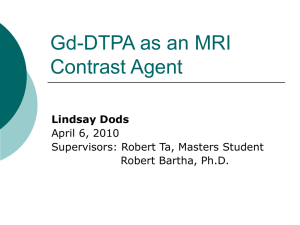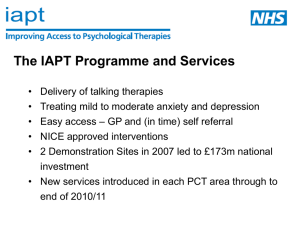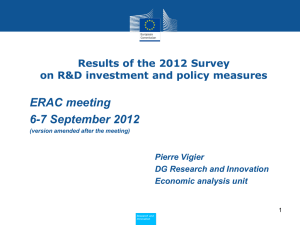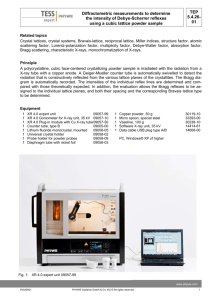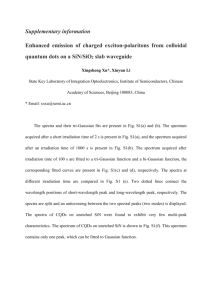ppt
advertisement
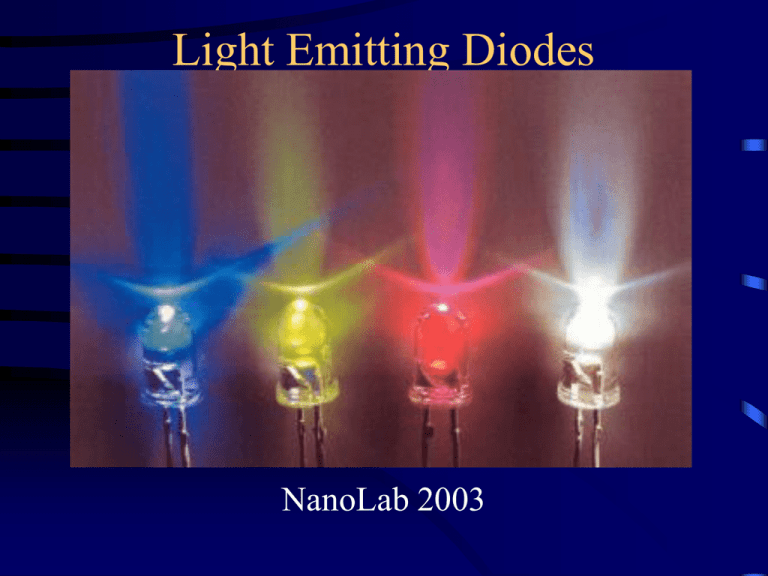
Light Emitting Diodes NanoLab 2003 Outline • • • • • Motivation/Applications: Why LED’s? Background Fabrication Testing Conclusions Motivation/Applications: Why LED’s? • Wide range of colors • Efficient and Reliable – Saves money • Requires less money to operate • Generates less heat – Good for electronics – Reduced AC costs • Last longer Why Do We Care? Efficiency (lumens/watt) Light Bulbs vs LED’s • Light Bulbs –Filament • Sudden FailureBreaks/Burns down –Recent bulbs last up to two years at ~20 lumens/watt –Fluorescent tubes last about 7500 hrs at ~80 lumens/watt • LED’s –No filament • Gradual Failure-Intensity decrease over time –Last from 50,000 to 100,000 hrs (5-10 yrs) –Recent LED’s (orange,red) have efficiency of ~100 lumens/watt – Generate little heat • Reduced A/C costs Applications •Communication (fiber optics) •Blue Laser Diodes –Video Recording –Data Storage –Televisions –Video Games –High Density DVD’s –DVD-ROM drive • Extra Motivation: –First company to produce efficient, reliable, costeffective WHITE LED’s will make lots of money. Isolated Atoms > Crystal > Artificial Atom Diamond lattice isolated atom Background-Band Gaps and Lattice Constants • Lattice mismatch reduces efficiency Background-Band Gaps and Lattice Constants Bandgap energy vs lattice constant of various IIIsemiconductors at room temperature. What are the III-Vs Background-Band Gaps and Lattice Constants Room-temperature bandgap energy vs lattice constant of common elemental and binary semiconductors. Background -Lattice Mismatch Two crystals with mismatched lattice constants resultion in dislocation at or near the interface between the two semiconductors. • Lattice mismatch reduces efficiency Background: pn Junctions and Recombination Carrier distribution in pn homojunctions • Electron from donor material recombines with hole in acceptor material. • Produces photon with energy hv equal to that of the band gap. • Smaller band gaps give infrared/red light; larger band gaps give blue/UV light Background: pn Junctions and Recombination Heterojunction under forward bias • Electron and holes are trapped in the quantum wells. • Such spatial overlap gratly enhances the recombination rate - brightness, efficiency. Background: Ohmic Contacts Contacts Relatively little resistance • http://nina.ecse.rpi.edu/shur/Ch3/sld043.htm Doping Hole in lower energy band allows for easier travel for electrons Electrons forced to higher, partially filled band electron moves easier Making our Samples • We are working with two different samples – GaAsP/GaAs – GaAs/GaAs • We dope the sample with ZnAs (p-type) using the quartz ampoule method – ZnAs and our sample are cleaned using TCE, Acetone, and Methanol – Our quartz is cleaned using 2.5% HF – Seal the ZnAs and our sample in quartz with vacuum – Bake for 15 minutes for roughly 2 mm of diffusion Making the Samples • We use a black wax (softening point at T~140oC) and 1% Bromine in Methanol etch to make contacts Test LED’s using curve tracer • Check to see that device actually works Current I (mA) • Find turn-on voltage Voltage V (V) Red LED at 1.5V, 16mA • P=VI, the less power it takes to operate the device, the better The Setup SpectraPro Laser Sample Optic cable Lens The Setup Continued SpectraPro Setup Curve tracer Gratings for SpectraPro One of our LED’s Current (mA) Voltage (V) Red LED, 1.5V,15mA Testing Our Sample Intensity v Wavelength • Use SpectraPro-150 to test wavelength, relative Green Laser intensity, and spectral length of our LED 150000 Intensity Red LED 50000 0 400 Intensity v Wavelength Red Laser 450 500 550 600 650 700 Wavelength (nm) 500000 Intensity Testing with Intensity lasers 100000 400000 300000 Intensity 200000 100000 0 400 450 500 550 600 Wavelength (nm) 650 700 750 Intensity Intensity 700000 600000 500000 Some Intensity LED’s 400000 300000 200000 100000 0 400 Intensity v Wavelength 450 500 550 600 650 700 750 Wavelength (nm) 12000 10000 8000 6000 Intensity 4000 2000 0 400 450 500 550 600 650 Wavelength (nm) 700 750 Intensity Intensity v Wavelength 40000 35000 30000 25000 20000 15000 10000 5000 0 400 Intensity 450 500 550 600 650 Wavelength (nm) White LED: RGB 700 750 Conclusions • Several samples were made – Most did not reach a turn-on voltage when applying a current using the curve tracer – One LED was in the infrared range the other red – The two LEDs that did turn on were not all that efficient. References • Photos from Jason Rausch • E. Fred Schubert – www.lightemittingdiodes.org • Craford, M.George and Stringfellow, G.B. High Brightness Light Emitting Diodes. Academic Press, 1997. • Professor Colin J Humphreys – www.sterlinggroup.org.uk/lecture2001.htm




